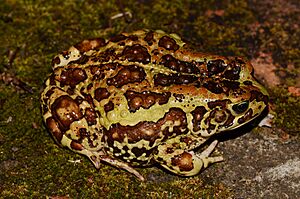Sclerophrys kerinyagae facts for kids
Quick facts for kids Sclerophrys kerinyagae |
|
|---|---|
 |
|
| Conservation status | |
| Scientific classification | |
| Synonyms | |
|
The Kerinyaga toad (scientific name: Sclerophrys kerinyagae), also known as Keith's toad, is a type of toad that belongs to the Bufonidae family. You can find this special toad in parts of central Ethiopia, Kenya, northern Tanzania, and eastern Uganda.
Contents
What Does the Kerinyaga Toad Look Like?
These toads are quite interesting! Adult male Kerinyaga toads usually measure about 60 to 85 millimeters (2.4 to 3.3 inches) long from their snout to their rear. Female toads are very similar in size, measuring 63 to 86 millimeters (2.5 to 3.4 inches).
Body Features of the Kerinyaga Toad
The Kerinyaga toad looks a lot like another toad called Sclerophrys regularis. Its snout, which is its nose area, is rounded. It has a clear, oval-shaped eardrum, called a tympanum, on the side of its head.
Near its eyes, it has special glands called parotoid glands that are almost touching its eyes. Its toes are partly webbed, meaning there's some skin between them, like a duck's foot.
Skin and Texture
The skin on the toad's back and sides is covered with small, cone-shaped bumps called warts. These warts have sharp, brown, hard points on them. The skin on its belly is rough and bumpy.
How Do Male Toads Communicate?
Male Kerinyaga toads have a single vocal sac under their chin. They use this sac to make calls, especially to attract mates. Their calls are made up of very fast pulses, about 38 to 48 pulses every second. This is much faster than the calls of Sclerophrys regularis, which only has 13 to 18 pulses per second.
Where Do Kerinyaga Toads Live and How Are They Protected?
Kerinyaga toads live in mountain grasslands and at the edges of forests. They can be found at high elevations, from about 1,280 to 3,300 meters (4,200 to 10,800 feet) above sea level.
Breeding Habits
These toads like to breed in different types of water. They use permanent pools, temporary pools that fill up when it rains, and even flooded fields in the mountain grasslands.
Conservation Status
The Kerinyaga toad is a common species, which means there are many of them. Overall, they are not considered to be in danger. However, their homes are sometimes damaged because of human activities like building new settlements and too much overgrazing by farm animals. Luckily, these toads live in several protected areas, which helps keep them safe.


